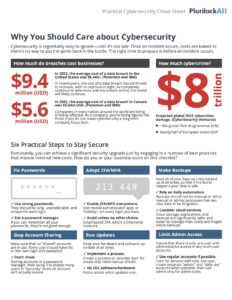In the ever-evolving landscape of cybersecurity, organizations face a constant barrage of cyber threats that can have significant implications for their operations, reputation, and bottom line. In this challenging environment, the concept of Mean Time to Resolution (MTTR) has emerged as a critical metric for cybersecurity professionals. MTTR measures the average time it takes to detect and resolve security incidents, playing a pivotal role in gauging an organization’s cyber resilience. This deep dive will explore what MTTR is, why it matters, and delve into an in-depth analysis of its importance in the realm of cybersecurity.
Understanding Mean Time to Resolution (MTTR)
Definition
MTTR is a key performance indicator (KPI) that quantifies the efficiency of incident response within an organization. It is defined as the average time it takes to detect a security incident, respond to it, and ultimately resolve the issue. The calculation involves measuring the time from the initial detection of an incident until the successful restoration of normal operations.
Components of MTTR
To comprehend MTTR fully, it is essential to break down its components:
- Detection Time: The period from the initial occurrence of a security incident to its detection. This can involve various methods such as intrusion detection systems, security information and event management (SIEM) tools, or manual monitoring.
- Response Time: The time taken to formulate and implement a response plan once a security incident has been identified. This involves actions like isolating affected systems, blocking malicious activities, and initiating investigations.
- Resolution Time: The duration required to fully resolve the security incident and restore affected systems to their normal functioning state. This may involve patching vulnerabilities, removing malware, or implementing other corrective measures.
Importance of MTTR
Rapid Incident Response
In the dynamic cybersecurity landscape, time is of the essence. Cyber threats evolve swiftly, and delaying the detection and resolution of an incident can have severe consequences. A rapid MTTR indicates an organization’s ability to respond promptly to security incidents, minimizing the potential damage.
Minimizing Downtime
Downtime is a critical factor for any organization. Extended periods of system unavailability not only impact productivity but can also result in financial losses and damage to the organization’s reputation. MTTR directly addresses this concern by focusing on minimizing the time systems remain compromised.
Reducing Impact on Stakeholders
Cybersecurity incidents can affect various stakeholders, including customers, employees, and partners. A swift MTTR reduces the duration of disruption and limits the impact on these stakeholders, fostering trust and confidence in the organization’s ability to handle security incidents.
The Significance of MTTR in Cybersecurity
Early Detection and Prevention
MTTR is closely linked to an organization’s capability to detect security incidents promptly. Early detection allows security teams to intervene before the threat escalates, preventing potential data breaches or system compromises. This emphasizes the importance of having robust monitoring tools and proactive threat intelligence to enhance early detection capabilities.
Operational Efficiency
Efficient incident response is contingent on well-defined processes and the availability of skilled personnel. Organizations must invest in training and equipping their cybersecurity teams to respond effectively to diverse and sophisticated cyber threats. Automation tools and playbooks can also streamline incident response workflows, contributing to a faster MTTR.
Continuous Improvement
MTTR serves as a benchmark for assessing the effectiveness of an organization’s cybersecurity strategy. Regularly monitoring and analyzing MTTR metrics can provide insights into the efficiency of existing security measures and identify areas for improvement. This data-driven approach facilitates a cycle of continuous improvement in cybersecurity capabilities.
Challenges in Achieving a Low MTTR
While a low MTTR is desirable, achieving it poses several challenges for organizations:
Complex IT Environments
Modern organizations often operate in complex IT environments with diverse infrastructure, applications, and interconnected systems. The complexity introduces challenges in detecting and resolving incidents swiftly, especially when they span multiple layers of the IT landscape.
Skill Shortages
The cybersecurity skills gap is a pervasive challenge, with a shortage of qualified professionals in the field. A lack of skilled personnel can hinder the speed and effectiveness of incident response efforts, potentially leading to a higher MTTR.
Evolving Threat Landscape
Cyber threats are constantly evolving, becoming more sophisticated and harder to detect. Organizations need to stay ahead of these threats by implementing advanced threat detection technologies and continuously updating their cybersecurity strategies to maintain a low MTTR.
Strategies for Improving MTTR
Incident Response Planning
Effective incident response begins with comprehensive planning. Organizations should develop and regularly update incident response plans that outline clear roles and responsibilities, communication protocols, and predefined response actions. Conducting regular drills and simulations ensures that the incident response team is well-prepared for various scenarios.
Automation and Orchestration
Automation plays a crucial role in accelerating incident response. Security orchestration and automation platforms can streamline routine tasks, allowing security teams to focus on more complex aspects of incident resolution. Automated responses can be triggered for known threats, reducing manual intervention and decreasing MTTR.
Collaboration and Information Sharing
Collaboration within the cybersecurity community is essential for staying informed about emerging threats and sharing best practices. Threat intelligence sharing platforms and industry collaborations enable organizations to benefit from collective knowledge, enhancing their ability to detect and respond to incidents quickly.
Continuous Training and Skill Development
Investing in the ongoing training and skill development of cybersecurity professionals is vital. This includes staying updated on the latest threat landscapes, acquiring new certifications, and participating in industry conferences. Well-trained personnel are better equipped to handle incidents swiftly, contributing to a lower MTTR.
Data-driven Analysis
Regularly analyzing incident data and MTTR metrics provides valuable insights into the effectiveness of cybersecurity measures. Organizations should leverage data analytics tools to identify trends, patterns, and areas for improvement. This data-driven approach enables informed decision-making and enhances overall cybersecurity posture.
Case Studies: The Impact of MTTR in Real-world Incidents
Equifax Data Breach (2017)
The Equifax data breach in 2017 serves as a poignant example of the repercussions of a prolonged MTTR. The breach exposed sensitive personal information of 147 million individuals, leading to widespread financial and reputational damage for the company. Investigations revealed that the breach occurred due to the exploitation of a known vulnerability that could have been patched earlier. The extended MTTR in this case highlighted the importance of timely patching and efficient incident response.
NotPetya Ransomware Attack (2017)
The NotPetya ransomware attack targeted organizations worldwide, causing significant disruptions and financial losses. One of the affected companies, Maersk, demonstrated the impact of a swift MTTR. Despite the widespread nature of the attack, Maersk reported a relatively short MTTR due to a well-prepared incident response plan. The company’s ability to recover quickly minimized the overall damage and showcased the importance of proactive incident response strategies.
Conclusion
Mean Time to Resolution (MTTR) stands as a critical metric in the realm of cybersecurity, reflecting an organization’s ability to detect, respond to, and resolve security incidents efficiently. As cyber threats continue to evolve in complexity and frequency, organizations must prioritize achieving a low MTTR to mitigate the potential impact on their operations, reputation, and stakeholders.
Investing in incident response planning, automation, collaboration, continuous training, and data-driven analysis are key strategies to improve MTTR. Real-world incidents, such as the Equifax data breach and the NotPetya ransomware attack, underscore the tangible consequences of a prolonged MTTR and highlight the importance of proactive cybersecurity measures.
In conclusion, organizations that prioritize a swift MTTR are better positioned to navigate the ever-changing landscape of cybersecurity, demonstrating resilience in the face of emerging threats and safeguarding their digital assets.













